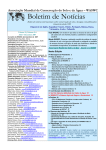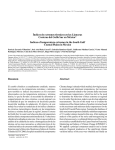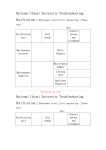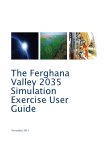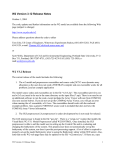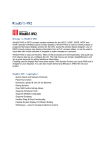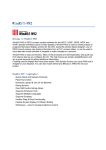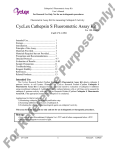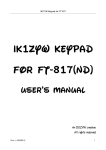Download User`s Manual - CA Water Info
Transcript
ARAL SEA BEAM (BASIN ECONOMIC ALLOCATION MODEL) USER’S MANUAL November 2012 Contents Introduction ............................................................................................................................... 1 What is BEAM? ............................................................................................................. 1 How to use this manual ................................................................................................. 2 Before using BEAM .................................................................................................................. 3 What do you need to have in order to work with the model? ........................................ 3 How to access the user interface .................................................................................. 3 How to log in .................................................................................................................. 3 How to create a new scenario ....................................................................................... 4 Modifying input data and developing scenarios ....................................................................... 7 How to modify input data and develop scenarios.......................................................... 7 How to modify crop sales prices .................................................................................... 8 How to modify crop input factor prices .......................................................................... 9 How to modify electricity prices ................................................................................... 10 How to modify the extent to which inter-annual carryover storage can be used or conserved.................................................................................................................... 11 How to modify the allocation of water to the Aral Sea................................................. 12 How to modify the group of “flexible” crops ................................................................. 13 How to introduce new reservoirs and hydropower facilities ........................................ 14 How to modify hydrological conditions ........................................................................ 15 How to modify demographic conditions ...................................................................... 16 How to modify the “flexibility” parameter ..................................................................... 17 How to modify the level of investment in irrigation efficiency improvements .............. 18 How to allow for new lands to be brought into irrigated production ............................ 19 Running the GAMS model and retrieving results ................................................................... 20 How to run the GAMS model....................................................................................... 20 How to retrieve results ................................................................................................. 21 Viewing and working with results ........................................................................................... 20 How to update the output Excel file with results from the GAMS model ..................... 20 How is the output Excel file organized ........................................................................ 20 How to view the model schematic ............................................................................... 21 How to view assumptions used in a model scenario................................................... 22 How to view summary economic data ......................................................................... 23 How to view summary hydropower data ..................................................................... 25 How to view summary agricultural data ...................................................................... 26 How to view agricultural data that are disaggregated by planning zone ..................... 28 How to view information about reservoir operations ................................................... 31 How to view other information about the water balance of the basin .......................... 32 Reporting ................................................................................................................................ 33 Which charts can be used to report on effectiveness impacts? .................................. 33 Which charts can be used to report on efficiency impacts? ........................................ 35 Which charts can be used to report on equity impacts? ............................................. 36 Introduction This manual presents the web-based user interface for the model, named the Aral Sea BEAM (Basin Economic Water Allocation). The model has been developed by Global Water Partnership, DHI and COWI on behalf of the EC IFAS (Executive Committee of the International Fund for Saving the Aral Sea) in during a study, which was carried out from August 2011 to October 2012.The USAID provided financial support for the study in question. In brief, the Aral Sea BEAM (henceforth: BEAM) constitutes a decision support system to investigate the welfare impacts of changes to water allocation mechanisms and water management infrastructure in the Aral Sea basin. The model is coded in the GAMS software environment. The web-based user interface allows a user to change model inputs and parameters without making changes to the underlying model code. The web-based interface generates a result file in an Excel spreadsheet format to facilitate viewing and processing of results. In this way, the model is accessible to all with access to the Internet. What is BEAM? BEAM is a computer based model that is used to simulate the water resources of the Aral Sea basin. BEAM includes hydrological elements such as inflows from mountain catchments; infrastructure elements such as reservoirs and canals; and economic elements such as hydropower facilities and irrigated farms. Water in the natural environment is simulated through simulation of flows through the river system as well through a mass balance of the Aral Sea and other terminal lakes. BEAM belongs to a class of simulation models called river basin planning models, or water resources planning models. These models are used for optimization of reservoir operations, analysis and optimization of water allocation institutions, and long-term water supply planning. The focus of these models is on representing the essential hydrological, infrastructure, and institutional components of a water resources system. These models generally do not feature detailed representations of physical processes such as rainfall-runoff relationships, river hydraulics, or water quality, although some aspects of these processes can be included. BEAM is different from most other river basin planning models with respect to the way in which water is allocated by the model. In most other river basin planning models, water is allocated using fixed demands and/or prioritization schemes that satisfy some water uses before others (e.g., domestic use may take priority over irrigation). In the BEAM representation, water is allocated according to economic optimization criteria. In other words, the BEAM model allocates water across time and space to different uses so that the economic value of water use is maximized. The purpose of the BEAM model is to explore whether it Box 1 Aral Sea basin at a glance The Aral Sea basin comprises 5 countries with a total population of a little more than 60 million over an 2 area of 4 mllion km . The 5 countries are: Kazakhstan, Kyrgyz Republic, Tajikistan, Turkmenistan and Uzbekistan. They are all former Soviet republics. Also, the basin comprises parts of Afghanistan and Iraq. A characteristic feature of the basin is that there are large differences in available water resources - from 3 Tajikistan with an average of about 5,000 m available per person annually to Turkmenistan with a little 3 less than 300 m available per person annually. Tajikistan and the Kyrgyz Republic include the major glaciated mountains of the basin and their upstream position is advantageous for water availability and, not least, hydropower. In contrast, Kazakhstan, Turkmenistan and Uzbekistan are in a downstream position. They are largely dependent on inflow from the two upstream countries. Agriculture is a key component of the basin’s economy and accounts for as much as 90% of its water use. However, hydropower may account for an increasing share of water use in future insofar as the upstream countries have planned various dams to increase hydropower production, such as the Rogun dam on the Vakhsh River in Tajikistan. If so, it will have some serious impacts on downstream agriculture. Climate change is expected to have a significant impact in the basin. The countries will face warmer temperatures, a changing hydrology and more extreme weather. Water scarcity will become a major challenge. 1 may be possible to change existing water allocation patterns in ways that enhance overall welfare in the Aral Sea basin. The BEAM model also facilitates the estimation of the economic impact of changes to water allocation patterns on different groups within the basin, including the riparian states as well as different sectors such as irrigation and hydropower. The model further allows the user to estimate the economic impact of changes to physical infrastructure such as new reservoirs and irrigation efficiency improvements. The BEAM simulation runs on a monthly time step for one year. The simulation period corresponds to the hydrological year used for water planning in the Aral Sea basin. This hydrological year begins on 1 October and ends on 30 September. How to use this manual This manual provides instructions for running BEAM and viewing results using the BEAM user interface. The BEAM user interface is accessed from the Internet. A specially designed website hosts the user interface, which consists of a web portal that is used to define scenarios, run the model, and access results. The web portal enables the user to select model input parameter values using input boxes and pull-down menus. After a scenario has been defined, the user runs the GAMS model, after which an Excel spreadsheet file containing model results is made available for download. The output Excel file contains tables and charts containing summary and detailed results. The Excel format facilitates the development of additional charts tailored to the user’s needs. To run BEAM and view results, the following steps are taken: 1. From the user interface, define the scenarios to be run. A scenario is a particular representation of the hydrological, infrastructure, and economic components of the river basin. 2. Run the GAMS model. 3. Retrieve the results file and view results. This manual provides information about carrying out the above steps. 2 Before using BEAM What do you need to have in order to work with the model? In order to work with BEAM, the following are required: 1. A personal computer. 2. Microsoft Excel. 3. Access to the Internet. How to access the user interface The user interface is accessed through the following link: http://beam.cowi.com. How to log in The first window you will see looks as follows: 5 1 4 3 2 Most important is that you may log in from this window. However, other services are provided. Below all services provided are mentioned – one by one: 1. You will see a picture, two arrows (one to the left, one to the right) and a short text. If you click on the arrows you will arrive at another picture with another short text about the model. In all, there are three pictures and hence three short texts. Please note that whenever you find some text in blue, you may click on it, thereby activating the underlying hyperlink. 2. At the bottom you will find hyperlinks to the EC IFAS website, the website of Alfred Diebold named “Water Unites” and model team. If you have a question, you are most welcome to drop a mail to the model team. It will do its best to answer your question within 5 working days. 3 3. To the left of the picture there is a heading labelled “More information”. Here you may download a brief and two manuals, including the current manual. They are available in English and Russian languages. 4. First time you want to log in, you will have to create an account. This you do by clicking the hyperlink just below the heading “Don’t have an account?”, filling in the form that appears and simply submitting it. Having done this you will be logged in. When filling in the form, you will be asked to provide an email address and a password (you choose the password yourself). 5. Next time you want to log in, you do this simply by providing your email address and password. How to create a new scenario When you log in for the first time you will see the below window: You create your first scenario by clicking on the blue button labeled “Create new scenario”. 4 Having done this the window below will appear: Briefly speaking, you give your scenario a name, make choices in the window and click “Save scenario”. 5 You will then come back to the window providing an overview of the scenarios you have created. The window you will see looks as follows, if the scenario name chosen is “Dry year”: 2 1 You may then create yet another scenario or run the scenario “Dry year”. If you want to run the scenario “Dry year” and afterwards download and watch the results you do the following: 1. You click the button “Run”. Then the underlying GAMS model is running. When it is running the label “Click to run the scenario” will change into “Scenario is running”. After a couple of minutes the results should be ready. Then you will have to reload (or refresh) the page. If you do so and the results are ready, the label “Scenario is running” will change into “These are the latest results”. 2. Having done this, the scenario will appear to the left in the window. Here you may download the results simply by clicking the hyperlink labelled “Download results”. A zip file containing scenario results will then be downloaded to your computer. You may also re-run the scenario, edit it or delete it. At any time it is possible to modify (or edit) a scenario. Likewise, it is possible to delete a scenario. Please note that whenever you delete a scenario you also delete accompanying results. There is no limit for the number of scenarios. In the remaining sections of this manual we will look at modifying input data and developing scenarios, viewing and working with results – and reporting. 6 Modifying input data and developing scenarios How to modify input data and develop scenarios The user interface is used to modify input data and develop scenarios. A scenario is set of model assumptions defined by the user for the purpose of investigating how these assumptions might affect water use and welfare in the basin. It is possible to modify the following types of assumptions in BEAM: 1. Crop sales prices. 2. Crop input factor prices. 3. An option to bring new irrigated lands into production. 4. Electricity prices. 5. Allocation of water to the Aral Sea. 6. Types of crops for which cropping patterns may change from the baseline (flexible crops). 7. New reservoirs and hydropower facilities. 8. Hydrological conditions. 9. Demographic conditions (which affect domestic and industrial water demands). 10. Flexibility parameter regarding flexible crops. 11. The level of investment in irrigation efficiency improvements. 12. The extent to which inter-annual carryover storage can be used or conserved in a given year. Any combination of the types of assumptions listed above may be used to define a scenario. 7 How to modify crop sales prices Crop sales prices are modified using the following step. 1. Define or modify crop prices for all active crops in the model by changing the prices listed in the section with the heading “Crop prices”. All prices must be given in units of USD/ton. 1 8 How to modify crop input factor prices It is possible to modify the prices of inputs to crop production including labor, capital, and a third aggregate input called “Others” that includes non-capital factors such as fertilizer, seeds, fuel, and pesticides. Crop input factor prices are modified using the following step. 1. Modify crop input factor prices by changing the percentage terms listed in the section “Input prices”. All input factor prices are adjusted using percentage terms that relate scenario prices to baseline prices. These percentages are applied throughout the study area. It is not possible to adjust factor prices by crop type or by region. 1 9 How to allow for new lands to be brought into irrigated production It is possible to allow for new lands to be brought into irrigated production. The model may then increase the total irrigated area in one or more planning zones if this is economically optimal. If the user exercises this option, then total irrigated area of all planning zones is increased by a user-specified percentage (relative to the observed baseline). It is not possible to use different percentages in different planning zones. If the irrigated area increases, only crops selected as “flexible” crops can expand to fill the newly irrigated area. To allow for new irrigated lands to be brought into production: 1. Enter the percentage increase to be allowed in the cell labelled “Extra land” in the section “Allow extra land”. 1 10 How to modify electricity prices Electricity prices affect the value of hydropower production and therefore have an impact on the amount of water released through hydropower facilities. Electricity prices vary by month but not by location (i.e., it is assumed that prices change in response to seasonal demand changes, but that prices reflect the cost of importing alternative power supplies on a common system in the region). To modify electricity prices: 1. Modify prices given in the section “Electricity price”. Prices should be given in units of USD/MWh. 1 11 How to modify the allocation of water to the Aral Sea When water is allocated according to economic optimization criteria, the allocation is constrained so that flows will reach the Aral Sea (i.e., Aral Sea demands must be satisfied before water can be allocated to other uses). The Aral Sea is divided into northern and southern parts because of the dike that has been built to conserve the northern portion of the sea. It is possible to increase the amount of water reaching each sea in order to investigate the economic impact of reserving more water for the Aral Sea. The baseline quantities allocated to the Aral Sea depend on the hydrological conditions selected for the scenario. If “Normal (2008-2009)” conditions are selected under “”Runoff base year” (see below), then 8 3 3 km /year are reserved for the South Aral Sea and 4 km /year are reserved for the North Aral Sea. If “Dry 3 (2000-2001)” conditions are selected, then only 2 km /year are reserved for the South Aral Sea and 1.5 3 km /year are reserved for the North Aral Sea. The annual requirement is distributed through the months of the year so that some flow must reach each sea in every month. The amount of water reaching either of the seas can be increased using the following step: 1. Specify the increase in the annual water requirement by modifying the numbers in the cells in the 3 section with the heading “Nature extra”. The units must be in mm /year. 1 12 How to modify the group of flexible crops The group of flexible crops is a group of crops for which cropping patterns are allowed to change from the baseline in response to water availability and other economic factors when running the GAMS model. The group of flexible crops can include any combination of cotton, wheat, rice, and alfalfa (see also below under “How to modify the flexibility parameter”). The group of flexible crops is modified using the following step: 1. Simply tick in the crops you wan to define as flexible crops. The crops you have ticked in then belong to the group of flexible crops. 1 13 How to introduce new reservoirs and hydropower facilities It is possible to include proposed reservoirs and/or hydropower facilities in a scenario to estimate the impact of these facilities on basin-wide welfare. A total of four proposed projects can be included: Dashtijum, Rogun, Kambarata-1, and Yavan. To include proposed reservoirs and/or hydropower facilities: 1. Tick in the reservoirs and/or hydropower facilities you would like to include in the section under the heading “New reservoirs in use”. 1 14 How to modify hydrological conditions It is possible to use two sets of assumptions about hydrological conditions in BEAM. The first assumes that inflows to the river system from mountain catchments are the same as those observed during the 2009 hydrological year. A hydrological ear runs from 1 October Year X to 30 September Year x+1. Hence, the 2009 hydrological year runs from 1 October 2008 to 30 September 2009. The 2009 year was considered an average or normal year in the basin. The second set of assumptions assumes that inflows to the river system from mountain catchments are the same as those observed during the 2001 hydrological year. The 2001 hydrological year runs from 1 October 2000 to 30 September 2001. The 2001 year was considered a dry year in the basin. To modify hydrological conditions: 1. Select a hydrological year using the drop-down menu in the section “Runoff base year”. 1 15 How to modify demographic conditions Demographic conditions are assumed to control domestic and industrial water use in the model. Domestic and industrial water uses are implemented in BEAM as constraints (i.e., these water uses must be satisfied before water can be allocated to other uses). It is assumed that domestic and industrial water use will vary with population. It is possible to select three levels of demographic conditions: population levels observed during the 2009 base year; projections for the year 2020; and projections for the year 2050. To modify demographic conditions: 1. Select a set of demographic conditions using the drop-down menu in the section “Demography”. 1 16 How to modify the flexibility parameter The so-called “flexibility parameter” controls the extent to which cropping patterns may change relative to an observed baseline. The model baseline consists of cropping patterns and other conditions observed in 2009. When land and water are allocated according to economic optimization criteria, the flexibility parameter controls the extent to which cropping patterns may change. The flexibility parameter is modified using the following step: 1. Modify the flexibility parameter using the drop-down menu under the heading “Flexible crop flexibility”. 1 17 How to modify the level of irrigation investments It is possible to develop scenarios that simulate the impact of irrigation efficiency improvements. These scenarios assume that irrigation water use decreases in response to investment in water saving technologies. Investments in irrigation efficiency improvements may include both area-related costs and water use-related costs. Water savings and cost information are modified by the user. To modify irrigation efficiency data: 1. Modify the level of water savings by changing the value in the cell labelled “Efficiency % improvement” in the section with the heading “Irrigation investments”. The value should be the percentage reduction in per hectare water use relative to baseline crop water use. The same percentage reduction is applied to all crop types and at all locations (i.e., it is not possible to specify percentages for different crops or locations). 2. Provide the costs for the two different cost categories used (i.e., area-related costs and water use-related costs). The per hectare cost of installing and operating water saving technologies is inserted in the cell labelled “Area cost (USD/ha)”. The per unit water cost of operating water saving technologies is inserted in the cell labelled “Volumetric cost (USD/1000m3)”. 1 2 18 How to modify the extent to which inter-annual carryover storage can be used or conserved BEAM runs for a time period of one year, and storage at the beginning of the simulation period is normally constrained to equal storage at the end of the simulation period; otherwise, it is possible that the optimization model would reduce end-of-period reservoir storages to unrealistic levels. However, some of the reservoirs in the Aral Sea basin were built to provide inter-annual carryover storage to supplement flows during dry years. The user can choose to use or conserve a portion of this storage by modifying the percentage share in the section with the heading “Use or conserve inter-annual reservoir storage (% of max)”. The user selects the portion of reservoir storage to use or conserve as a percentage of the maximum capacity. If a negative value is entered, the end of period storage will be less than the beginning of period storage (in other words, inter-annual storage will be used). If a positive value is entered, the end of period storage will be greater than the beginning of period storage (inter-annual storage will be conserved). The option to use or conserve inter-annual storage is applied to Toktogul and Nurek reservoirs only. The parameter is modified as follows: 1. Modify the inter-annual storage parameter by changing the value in the section “Use or conserve inter-annual reservoir storage (% of max)”. The value should be given in units of percentage of maximum reservoir capacity. 1 19 Viewing and working with results How to update the output Excel file with results from the GAMS model The zip file containing model contains an .xls file used to display model results and a number of .csv files containing output from the GAMS model. The contents of the .csv files must be imported into the .xls file by the user. To import model output into the .xls file: 1. Unzip the contents of the downloaded zip file into a new directory. 2. Open the .xls file, which is called “beamOutput.xls”. 3. Click on the control button “Refresh all CSV input data files” on the “frontpage” worksheet. 3 How is the output Excel file organized The output user interface consists of a number of worksheets that hold output from the GAMS model. These worksheets are organized into the following four groups: 1. The “frontpage” worksheet with the control button that is used to import GAMS model output. 2. A worksheet called “schematic” that holds the model schematic. 3. A set of worksheets with black-colored tabs holding summary output from the GAMS model. 4. A set of worksheets with blue-colored tabs holding direct output from the GAMS model. The data presented on the worksheets with black-colored tabs summarize data from the worksheets with blue-colored tabs. The data on the blue-colored tabs should only be accessed or altered by users familiar with the underlying GAMS model code. 5. A fourth group of worksheets containing information used to import data from the underlying GAMS model. The data on the fourth group of worksheets should only be accessed or altered by users familiar with the underlying GAMS model code. 20 How to view the model schematic The model schematic is available on the “schematic” worksheet. The model schematic includes six types of nodes: 1. Water source nodes represent inflows from rim catchments. 2. Reservoir nodes represent reservoir and hydropower facilities. The reservoir node type includes both existing and planned reservoirs. 3. River nodes represent junctions where two or more upstream nodes come together and/or where two or more downstream nodes diverge. 4. Planning zone nodes represent consumptive water use locations. 5. Return flow nodes represent return flows from consumptive water use locations. 6. Lake nodes represent terminal lakes. The arrows shown between nodes indicate the direction of flow. To interpret the schematic, a color scheme is used to identify different node types. To view the model schematic: 1. Navigate to the “schematic” worksheet. 1 21 How to view assumptions used in a model scenario The output user interface always presents results from two scenarios: the baseline scenario and the scenario that was defined using the input user interface. This facilitates the comparison of scenario results to the baseline. To keep track of assumptions used in a scenario, all assumptions are recorded on the “assumptions” worksheet. To view assumptions: 1. Navigate to the “assumptions” worksheet. Assumptions for baseline and Scenario Baseline 1.000 300 500 100 40 450 75 100% 100% 100% 0,50 0 0 Fixed Fixed Fixed Fixed 2009 2009 0 0 0% 0 0 0 0 0 0 70 70 60 50 40 30 30 40 50 50 60 65 0% 0% 0% 0% Cotton price USD/ton Wheat price USD/ton Rice price USD/ton Alfalfa price USD/ton Vegetable price USD/ton Fruit price USD/ton Other crops price USD/ton Labor price (% of baseline) Capital price (% of baseline) Diesel/fertilizer price (% of baseline) Crop change transformation elasticity Extra nature water need, Aral Sea North, mm3/year Extra nature water need, Aral Sea South, mm3/year Cotton flexible (0/1)? Wheat flexible (0/1)? Rice flexible (0/1)? Alfalfa flexible (0/1)? Rainfall year Modelled years Irrigation efficiency investment USD/ha Irrigation efficiency investment USD/m3 Irrigatopn efficiency improvement (%) Investments in Dashtijum Investments in Rogun Investments in Kambarata-1 Investments in Naryn cascade Investments in Vakhsh cascade Investments in Yavan Electricity price m01 USD/MWh Electricity price m02 USD/MWh Electricity price m03 USD/MWh Electricity price m04 USD/MWh Electricity price m05 USD/MWh Electricity price m06 USD/MWh Electricity price m07 USD/MWh Electricity price m08 USD/MWh Electricity price m09 USD/MWh Electricity price m10 USD/MWh Electricity price m11 USD/MWh Electricity price m12 USD/MWh Reservoir buildup Demographic change in water use, households Demographic change in water use, industry Fallow land 22 Scenario 1.000 300 500 100 40 450 75 100% 100% 100% 0,50 0 0 Flexible Flexible Flexible Flexible 2009 2009 0 0 0% 0 0 0 0 0 0 70 70 60 50 40 30 30 40 50 50 60 65 0,0% 0% 0% 0% 1 How to view summary economic data Summary economic data are available on the “economy” worksheet. Data are presented for both the baseline scenario and the user-defined scenario defined using the web interface. All data are aggregated to the basin-wide and annual levels, and are also disaggregated to national and monthly levels. The following types of summary data are presented: 1. Total value added: Total value added is the sum of agricultural value added and hydropower value added. For details of how value added is estimated, the reader is referred to the BEAM programmer’s manual. These tables allow the user to view the impact of a scenario on overall welfare relative to the baseline. The disaggregated data allow the user to see how the distribution of income changes with respect to geography (measured in terms of income to individual countries) and with respect to time (measured over the months of the year). 2. Agricultural value added: Agricultural value added is equal to agricultural production value minus agricultural input costs. These tables allow the user to view the impact of a scenario on the agriculture sector. For the agricultural sector, the distribution of value added over the months of the year is not meaningful because the monthly results presented in the table are simply equal to the annual value added divided by 12. The disaggregation to monthly data is made in this way to facilitate the presentation of monthly data in the “Total income” table. 3. Hydropower value added: These tables allow the user to view the impact of a scenario on the hydropower sector. These data are also disaggregated by country and by month. 1 2 3 4. Summary data are also available for hydropower production and irrigation investment costs. In the present version of BEAM, costs of hydropower production are assumed to zero. The summary data related to irrigation efficiency investment costs present costs result from irrigation investment assumptions defined using the input interface. 4 23 5. Summary value added data are also available as a per cent of GDP. This provides information about the importance of agriculture and hydropower in the basin to each of the riparian countries. GDP values used to prepare the tables are 2009 PPP figures. 5 6. Summary value added data are also available in per person GDP units. Each figure in the tables is equal to value added divided by per person GDP. This provides information about the importance of agriculture and hydropower in the basin to each of the riparian countries which controlling for population size. 6 Charts are also available for all tables presented in this section. 24 How to view summary hydropower data Summary hydropower data are available on the “HEPS” worksheet. The following types of summary data are presented: 1. Aggregated value added and generation data are presented at the basin and national level. The national-level aggregated data include only Kyrgyzstan and Tajikistan. The other riparian countries are not included because the overwhelming majority of hydropower production in the basin takes place in Kyrgyzstan and Tajikistan. 1 2. Hydropower generation and value added are also presented for individual reservoirs and hydropower facilities. 2 3. Average heads are also presented for all reservoirs and hydropower facilities. 3 Charts are also available for all tables presented in this section. 25 How to view summary agricultural data Summary agricultural data are available on the “agriculture” worksheet. All data are aggregated to the basin-wide level and are also disaggregated by country and by crop type. The following types of summary data are presented: 1. Agricultural value added: Agricultural value added is equal to the difference between agricultural production value and agricultural input costs. These tables allow the user to view the impact of a scenario on the welfare of the agricultural sector. The disaggregated data allow the user to see how the welfare impacts of a given scenario are distributed by country and by crop type. 2. Agricultural production value: Agricultural production value is equal to the product of agricultural production value and crop sakes price. These tables allow the user to view the impact of a scenario on gross revenue to agriculture. The disaggregated data allow the user to see how impacts are distributed by country and crop type. 3. Agricultural production: Agricultural production is equal to the product of crop yield times crop area. These tables allow the user to view the impact of a scenario on crop production. The disaggregated data allow the user to see how impacts are distributed by country and crop type. 1 2 3 26 4. Water use: These tables allow the user to view the impact of a scenario on agricultural water use. The disaggregated data allow the user to see how impacts are distributed by country and crop type. 5. Land use: These tables allow the user to view the impact of a scenario on agricultural land use. The disaggregated data allow the user to see how impacts are distributed by country and crop type. 6. Labor use: These tables allow the user to view the impact of a scenario on agricultural labor use. The disaggregated data allow the user to see how impacts are distributed by country and crop type. 4 5 5 6 5 7. Ratio of value added to water use: These tables allow the user to see how the ratio of value added to water use changes from the baseline to the scenario for each country and crop type. 8. Ratio of value added to land use: These tables allow the user to see how the ratio of value added land use changes from the baseline to the scenario for each country and crop type. 7 8 5 27 9. Yield: These tables allow the user to see how crop yields change from the baseline to the scenario for each country and crop type. 10. Water intensity: These tables allow the user to see how per hectare water use changes from the baseline to the scenario for each country and crop type. 9 10 5 Charts are also available for all tables presented in this section. How to view agricultural data that are disaggregated by planning zone Agricultural data that are disaggregated by planning zone are available on the “agricultureByZone” worksheet. Data presented are the same as data presented on the “agriculture” worksheet. The following types of summary data are presented: 1. Agricultural value added. 2. Agricultural production value. 1 2 28 3. Agricultural production. 4. Water use. 3 4 5. Land use. 5 6. Ratio of value added to land use. 7. Ratio of value added to water use. 29 6 7 8. Yield. 9. Water intensity. 8 9 Charts are also available for all tables presented in this section. 30 How to view information about reservoir operations Information about reservoir operations is available on the “reservoirs” worksheet. The following types of information are available: 1. Reservoir discharges, aggregated by country. 1 2. Reservoir storage changes, aggregated by river section. 2 3. Reservoir volumes, aggregated by river section. 3 4. Reservoir volumes, disaggregated by individual reservoir. 4 5. Reservoir discharges, disaggregated by individual reservoir. 5 31 6. Reservoir spills, disaggregated by individual reservoir. 6 Charts are also available for all tables presented in this section. How to view other information about the water balance of the basin Other information about the water balance of the basin is available on the worksheets “waterBalance” and “balanceZoneDetail”. Much of this information is used to check water balances within the GAMS model and for other quality assurance purposes. However, some of the information on these worksheets may be useful for interpreting scenario impacts. This information is summarized here. 1. Inflows to terminal lakes in the basin are presented in the tables called “Lake inflows” on the “waterBalance” worksheet. This information is useful for interpreting the impact of a particular scenario on inflows to the Aral Sea and other terminal lakes. 1 32 Reporting A number of charts have been developed in an effort to standardize the reporting of scenario results and facilitate the interpretation of scenario impacts. To be consistent with the goals of the project, it should be possible to interpret the results of each scenario in terms of impacts on effectiveness, efficiency, and equity. Each chart has been developed with the intention to provide information on the impacts of a scenario on one of these three considerations. Which charts can be used to report on effectiveness impacts? Effectiveness is defined as a measure of the extent to which water allocation institutions maximize welfare. Welfare is defined here at the basin scale. Therefore, a change to water allocation is considered to increase effectiveness if the change increases overall welfare at the basin scale. The following charts can be used to report on effectiveness impacts: 1. The chart titled “Annual basin income” on the “economy” worksheet compares overall basin value added for the baseline and the current scenario. Overall basin income is disaggregated into hydropower and irrigation (all other water uses are represented as constraints in the model and therefore do not appear in the basin income calculation). The comparison of overall income presented on the left of the chart is the best single measure of effectiveness impacts at the basin scale. Annual basin value added 12,000 10,000 1 10^6 USD 8,000 Baseline 6,000 Scenario 4,000 2,000 0 Total value added Agri. value added HEPS value added 33 2. Although disaggregated at country level, the charts comparing value added per unit land use and per unit water use on the “agriculture” worksheet give some insight into how the effectiveness of water use changes from the baseline to the scenario. Ratio of value added to land use, Uzbekistan 4,000 3,500 2,500 2,000 Baseline 1,500 Scenario 1,000 500 0 cot wht ric alf veg fru oth Ratio of value added to water use, Uzbekistan 350 300 USD/1000 m3 2 USD/hectare 3,000 250 200 Baseline 150 Scenario 100 50 0 cot wht ric alf veg fru 34 oth 3. Because reservoir operations are driven by economic optimization criteria in all scenarios, scenario results can provide insight into how to operate reservoirs in order to maximize effectiveness. The chart titled “Reservoir volume” on the “reservoirs” worksheet compares baseline and scenario reservoir storages for the Toktogul and Naryn reservoirs. This chart provides insight into how these reservoirs could be operated differently in order to maximize basin-wide economic welfare. 3 Which charts can be used to report on efficiency impacts? Efficiency is defined as a measure of water use per unit activity level. For example, the efficiency of water use in the production of irrigated cotton can be measured in terms of the annual amount of water used per hectare in production, or the amount of water used per tonne of output. Measures that increase efficiency, such as water-saving irrigation technologies, can release water for other uses and thereby enhance effectiveness. The following chart can be used to report on efficiency impacts: 1. The charts labelled “Water intensity” compare per hectare water use in the baseline and scenario. Water intensity, Kazakhstan 30,0 1 1000 m3/hectare 25,0 20,0 15,0 Baseline 10,0 Scenario 5,0 0,0 cot wht ric alf veg 35 fru oth Which charts can be used to report on equity impacts? Equity is defined as a measure the extent to which measures to improve efficiency and effectiveness affect the welfare of different groups in the region. Measures that increase overall welfare at the basin scale may have positive welfare impacts on some groups in the basin and negative impacts on other groups. Measures to increase efficiency may also have a range of impacts on different groups. The following charts can be used to report on equity impacts: 1. The chart titled “Annual national value added from HEPS” on the “economy” worksheet provides information about how welfare changes resulting from changes to hydropower production are distributed among the riparian countries. This chart is also available in GDP units. Annual national value added from HEPS 9.000 8.000 1 10^6 USD 7.000 6.000 5.000 Baseline 4.000 Scenario 3.000 2.000 1.000 0 KYR TAD TUR UZB KAZ 2. The chart titled “Annual national income from agriculture” on the “economy” worksheet provides information about how changes to income from agricultural production are distributed among the riparian countries. This chart is also available in GDP units. Annual national value added from agriculture 9.000 8.000 2 10^6 USD 7.000 6.000 5.000 Baseline 4.000 Scenario 3.000 2.000 1.000 0 KYR TAD TUR UZB 36 KAZ 3. The charts titled “Agricultural production” on the “agriculture” and the “agricultureByZone” worksheets provide information about changes in the production of crops in each country and planning zone. Agricultural production, Uzbekistan 25.000.000 3 ton/year 20.000.000 15.000.000 Baseline 10.000.000 Scenario 5.000.000 0 cot wht ric alf veg fru oth 4. The charts titled “Labor use” on the “agriculture” and the “agricultureByZone” worksheets provide information about changes in farm employment in each country and planning zone. Labor use 1.200.000 4 1000 USD/year 1.000.000 800.000 600.000 Baseline 400.000 Scenario 200.000 0 KYR TAD TUR UZB 37 KAZ







































